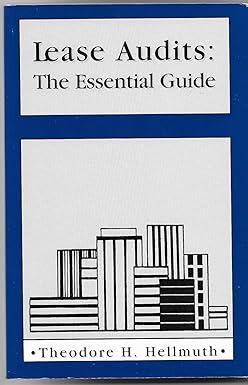Question
Strauss, an experienced business administrator, became unemployed six years ago when his firm downsized. He decided to set up his own business. He was interested
Strauss, an experienced business administrator, became unemployed six years ago when his firm downsized. He decided to set up his own business. He was interested in the lawn care business and thought that a franchised operation provided the best chance for quick success.
After examining a number of lawn care franchises, Strauss concluded that a firm called Sodmaster Inc. was the franchisor best suited to his requirements. Strauss contacted Sodmaster and had several discussions with the area manager for Eastern Ontario. Strauss was provided with a vast amount of information about Sodmasters operations, including various projections of costs and profits based on the operation of other Sodmaster franchises. Strauss also visited other franchisees and talked with them about their experiences.
According to the financial projections in the booklet given to him by Sodmaster, a franchise with a gross annual revenue of $200 000 would normally make a small loss (after allowing for a modest management fee); one with revenue of $400 000 would show a reasonable profit, and one with revenue of $800 000 or more would show an excellent profit. Potential franchisees were warned that it was unusual to break even in the first year of operation. The projections were essentially accurate, based on the actual experience of Sodmaster franchises, though the booklet failed to say that only one of the franchises actually grossed more than $800 000 per year.
Strauss also made his own projections of his probable revenues and decided to go ahead and purchase a franchise for Frontenac County, Ontario. He agreed to pay a franchise fee of $40 000 ($25 000 payable immediately and the balance after two years) and to pay royalties of 6 percent on gross revenues. He also entered into the usual restrictive covenants not to carry on a competing business within 30 km of the franchise area for a period of five years after termination of the franchise. In order to get started, Strauss borrowed money on the security of his home and, in all, invested about $100 000 of his own money.
The business did not work out nearly as well as Strauss had expected. In his first year, he had sales of only $60 000 (when he had anticipated twice that figure), and he made a loss of $75 000. The second years sales reached $100 000 (with a loss of $12 000); by the third year, sales had risen to $180 000, still with a small loss; in the fourth and fifth years, Strausss sales levelled out at a little more than $200 000, and he was still making a loss.
Because of his financial problems, Strauss never paid the remaining $15 000 owing on the franchise fee, and he also fell behind early on in the payment of the royalties. Eventually Sodmaster informed Strauss that they would not be prepared to renew the franchise at the end of its five-year term. Strauss then abandoned the franchise and set up his own lawn care business in the same area.
Sodmaster brought an action against Strauss, claiming payment of the balance of the franchise fee, the unpaid royalties, and an injunction to restrain the breach of the restrictive covenant. Strauss counterclaimed for damages, alleging he had been misled into entering into the franchise agreement in the first place. Who should succeed? Would your answer change if only 18 months had passed?
Step by Step Solution
There are 3 Steps involved in it
Step: 1

Get Instant Access to Expert-Tailored Solutions
See step-by-step solutions with expert insights and AI powered tools for academic success
Step: 2

Step: 3

Ace Your Homework with AI
Get the answers you need in no time with our AI-driven, step-by-step assistance
Get Started


